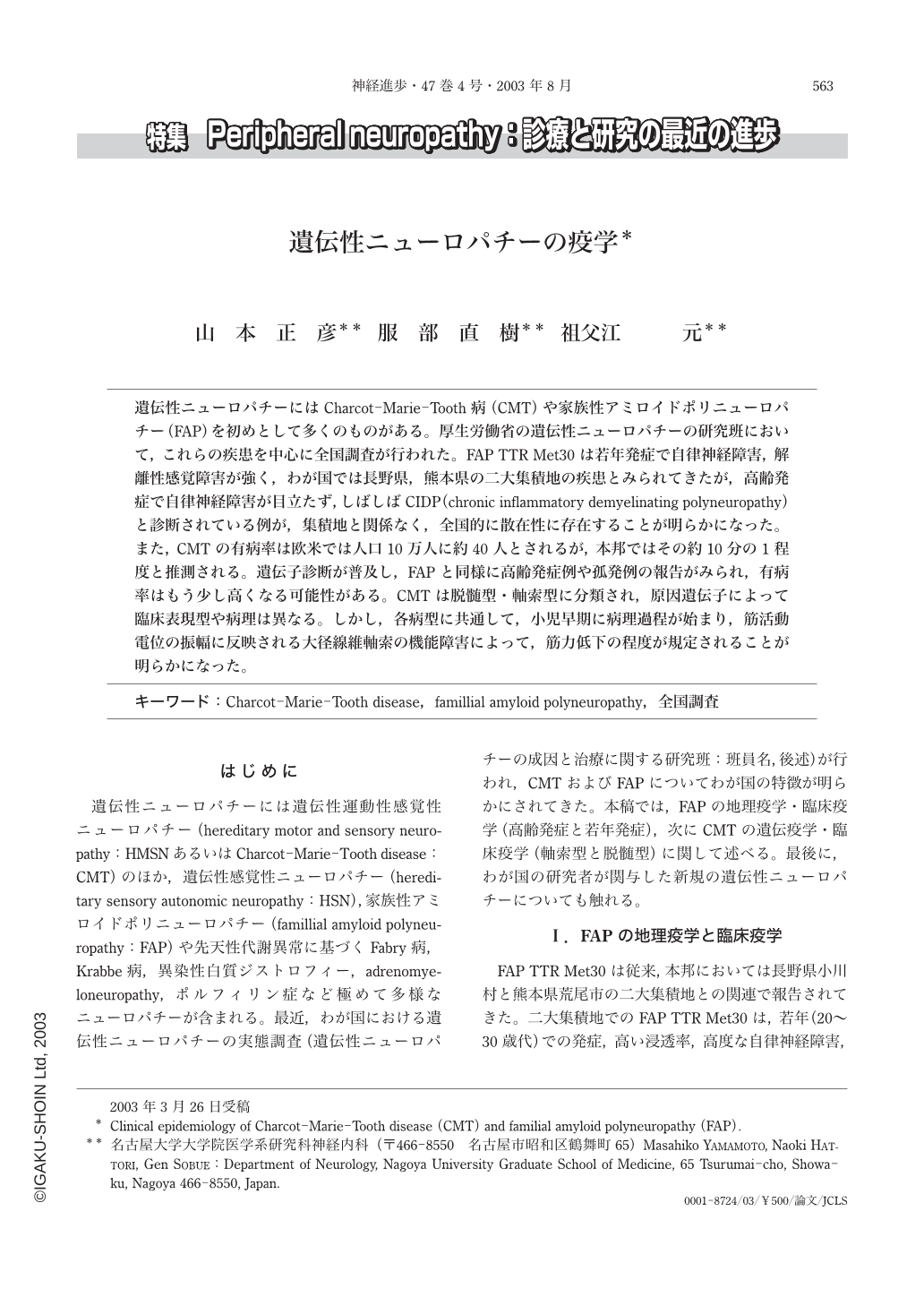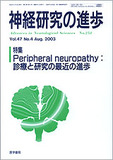Japanese
English
- 有料閲覧
- Abstract 文献概要
- 1ページ目 Look Inside
遺伝性ニューロパチーにはCharcot-Marie-Tooth病(CMT)や家族性アミロイドポリニューロパチー(FAP)を初めとして多くのものがある。厚生労働省の遺伝性ニューロパチーの研究班において,これらの疾患を中心に全国調査が行われた。FAP TTR Met30は若年発症で自律神経障害,解離性感覚障害が強く,わが国では長野県,熊本県の二大集積地の疾患とみられてきたが,高齢発症で自律神経障害が目立たず,しばしばCIDP(chronic inflammatory demyelinating polyneuropathy)と診断されている例が,集積地と関係なく,全国的に散在性に存在することが明らかになった。また,CMTの有病率は欧米では人口10万人に約40人とされるが,本邦ではその約10分の1程度と推測される。遺伝子診断が普及し,FAPと同様に高齢発症例や孤発例の報告がみられ,有病率はもう少し高くなる可能性がある。CMTは脱髄型・軸索型に分類され,原因遺伝子によって臨床表現型や病理は異なる。しかし,各病型に共通して,小児早期に病理過程が始まり,筋活動電位の振幅に反映される大径線維軸索の機能障害によって,筋力低下の程度が規定されることが明らかになった。
はじめに
遺伝性ニューロパチーには遺伝性運動性感覚性ニューロパチー(hereditary motor and sensory neuropathy:HMSNあるいはCharcot-Marie-Tooth disease:CMT)のほか,遺伝性感覚性ニューロパチー(hereditary sensory autonomic neuropathy:HSN),家族性アミロイドポリニューロパチー(famillial amyloid polyneuropathy:FAP)や先天性代謝異常に基づくFabry病,Krabbe病,異染性白質ジストロフィー,adrenomyeloneuropathy,ポルフィリン症など極めて多様なニューロパチーが含まれる。最近,わが国における遺伝性ニューロパチーの実態調査(遺伝性ニューロパチーの成因と治療に関する研究班:班員名,後述)が行われ,CMTおよびFAPについてわが国の特徴が明らかにされてきた。本稿では,FAPの地理疫学・臨床疫学(高齢発症と若年発症),次にCMTの遺伝疫学・臨床疫学(軸索型と脱髄型)に関して述べる。最後に,わが国の研究者が関与した新規の遺伝性ニューロパチーについても触れる。
A nationwide study of Charcot-Marie-Tooth disease(CMT)caused by gene mutations of myelin-related proteins(PMP22, P0/MPZ and Cx32), and familial amyloid polyneuropathy(FAP)with transthyretin mutations have been performed.
TypeI(transthyretin Met30)familial amyloid polyneuropathy(FAP TTR Met30)occurs in 2 endemic foci in Japan. We have reported late-onset Japanese cases unrelated to an endemic focus and showing distinctive clinicopathologic features. To compare clinical and geographic features of FAP TTR Met30 between patients with onset before and after 50 years of age, clinical information was obtained through a nationwide survey by the Study Group for Hereditary Neuropathy in Japan. Families with early-onset disease in this study numbered 82, and those with late onset, 59. In families with late onset, neuropathy showed male preponderance, low penetrance, little relationship to endemic foci, sensorimotor symptoms beginning distally in the lower extremities with disturbance of both superficial and deep sensation, and relatively mild autonomic symptoms, consistent with pathological findings. Families with early onset showed higher penetrance, concentration in endemic foci, predominant loss of superficial sensation, severe autonomic dysfunction, and atrioventricular nodal block requiring pacemaker implantation. This study confirmed differences in clinical and geographic features between early-and late-onset FAP TTR Met30. Late-onset cases with axonal phenotype may be more prevalent and widespread than previously believed.
Demyelinating versus axonal phenotypes are major issues in CMT. We electrophysiologically, pathologically and genetically evaluated demyelinating and axonal features of 205 Japanese patients with CMT1A(PMP22 duplication), CMT1B(P0/MPZ mutations), or CMTX(Cx32mutations). CMT1A caused mainly demyelinating phenotype with slowed motor nerve conduction velocity(MCV)and demyelinating histopathology, while axonal features were variably present. In CMT1B, two distinctive phenotypic subgroups were present:one showed preserved MCV and exclusively axonal pathologic features;and another was exclusively demyelinating. These axonal and demyelinating phenotypes were well concordant among siblings in individual families, and MPZ mutations were not overlapped among these two subgroups, suggesting that nature and position of the MPZ mutations mainly determine the axonal and demyelinating phenotypes. CMTX showed intermediate slowing of MCV, predominantly axonal features, and relatively mild demyelinating pathology. Differing from CMT1B, these axonal and demyelinating features were concomitantly present in individual patients in variable extent. Median nerve MCV and overall histopathologic phenotype changed little despite disease advancement. Axonal features of diminished amplitudes of compound muscle action potentials(CMAPs), axonal loss and neuropathic muscle wasting all accentuated as disease advanced, especially in CMT1A and CMTX. Median nerve MCVs were well maintained independently of age, disease duration, and severity of clinical and pathologic abnormalities, confirming that median nerve MCV is an excellent marker for the genetically determined neuropathic phenotypes. Amplitude of CMAPs was correlated significantly with distal muscle strength in CMT1A, CMT1B and CMTX, while MCV slowing was not, indicating that clinical weakness results from reduced numbers of functional large axons, not from demyelination. Thus the three major myelin-related protein mutations induce varied degrees of axonal and demyelinating phenotypic features according to the specific gene mutations as well as the stage of disease advancement, while clinically evident muscle wasting was attributable to loss of functioning large axons.
In hereditary neuropathy CMT and FAP are the most common types in the world. However, the prevalence rate of CMT in Japan was approximately 1.5-4 to 100,000, which was about one tenth compared to that reported in Caucasian population. CMT patients with demyelinating and/or axonal features, together with FAP patients with axonal feature and scattered distribution, are supposed to increase according to the development of genetic diagnosis for hereditary neuropathy that verifies late-onset, de novo and asymptomatic patients.

Copyright © 2003, Igaku-Shoin Ltd. All rights reserved.


